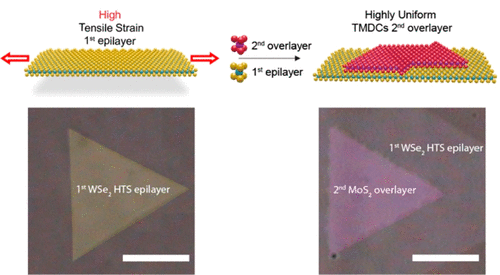当前位置:
X-MOL 学术
›
ACS Mater. Lett.
›
论文详情
Our official English website, www.x-mol.net, welcomes your
feedback! (Note: you will need to create a separate account there.)
Strain-Directed Layer-By-Layer Epitaxy Toward van der Waals Homo- and Heterostructures
ACS Materials Letters ( IF 9.6 ) Pub Date : 2021-03-25 , DOI: 10.1021/acsmaterialslett.0c00554 Yi Wan, Jing-Kai Huang, Chih-Piao Chuu, Wei-Ting Hsu, Chien-Ju Lee, Areej Aljarb, Chun-Wei Huang, Ming-Hui Chiu, Hao-Ling Tang, Ci Lin, Xuechun Zhang, Ching-Ming Wei, Sean Li, Wen-Hao Chang, Lain-Jong Li, Vincent Tung
ACS Materials Letters ( IF 9.6 ) Pub Date : 2021-03-25 , DOI: 10.1021/acsmaterialslett.0c00554 Yi Wan, Jing-Kai Huang, Chih-Piao Chuu, Wei-Ting Hsu, Chien-Ju Lee, Areej Aljarb, Chun-Wei Huang, Ming-Hui Chiu, Hao-Ling Tang, Ci Lin, Xuechun Zhang, Ching-Ming Wei, Sean Li, Wen-Hao Chang, Lain-Jong Li, Vincent Tung

|
Transition-metal dichalcogenide (TMDC) homo- and heterostacks hold tantalizing prospects for being integrated as active components in future van der Waals (vdW) electronics and optoelectronics. However, most TMDC homo- and heterostacks are created by onerous mechanical exfoliation, followed by a mixing-and-matching process. While versatile enough for pilot demonstrations, these strategies are clearly not scalable for practical technologies and widespread implementations. Here, we report a two-step epitaxy strategy that promotes the growth of second-layer TMDCs on the basal plane of the first TMDCs epilayer. The first-layer TMDCs are grown on substrates where the tensile strength can be tuned by the control of chemical environments. The succeeding epilayers then prefer to grow layer-by-layer on the highly tensile-strained first layers. The result is the growth of high-density TMDC homo (WSe2) bilayers and hetero (WSe2–MoS2) bilayers with an exceedingly high yield (>99% bilayers) and uniformity. A density functional theory simulation further sheds light on how strain engineering shifts the subsequent layer growth preference. Second-harmonic generation and high-angle annular dark-field scanning transmission electron microscopy collectively attest to the AB and AA′ stacking between the TMDC epi- and overlayers. The proposed strategy could be a versatile platform for synthesizing diverse arrays of vdW homo- and heterostacks, thus providing prospects for realizing large-scale and layer-controllable two-dimensional electronics.
中文翻译:

应变定向层外延向范德华同质和异质结构
过渡金属二硫化氢(TMDC)均质和异质堆栈有望成为未来的范德华(vdW)电子和光电产品中的有源组件,具有诱人的前景。但是,大多数TMDC同质和异质堆栈是通过繁重的机械剥离以及随后的混合匹配过程创建的。尽管这些策略足以进行试点演示,但这些策略显然无法扩展到实际技术和广泛的实施方式。在这里,我们报告了一个两步外延策略,该策略可在第一TMDC外延层的基面上促进第二层TMDC的生长。第一层TMDC生长在可以通过控制化学环境来调节抗张强度的基材上。然后,随后的外延层倾向于在高度拉伸应变的第一层上逐层生长。2)双层和杂种(WSe 2 -MoS 2)双层,具有极高的良率(> 99%双层)和均匀性。密度泛函理论仿真进一步阐明了应变工程如何改变随后的层生长偏好。二次谐波产生和高角度环形暗场扫描透射电子显微镜共同证明了TMDC外延层和叠加层之间的AB和AA'堆积。所提出的策略可能是用于合成vdW同质和异质堆栈的各种阵列的通用平台,从而为实现大规模且可控层的二维电子学提供了前景。
更新日期:2021-04-05
中文翻译:

应变定向层外延向范德华同质和异质结构
过渡金属二硫化氢(TMDC)均质和异质堆栈有望成为未来的范德华(vdW)电子和光电产品中的有源组件,具有诱人的前景。但是,大多数TMDC同质和异质堆栈是通过繁重的机械剥离以及随后的混合匹配过程创建的。尽管这些策略足以进行试点演示,但这些策略显然无法扩展到实际技术和广泛的实施方式。在这里,我们报告了一个两步外延策略,该策略可在第一TMDC外延层的基面上促进第二层TMDC的生长。第一层TMDC生长在可以通过控制化学环境来调节抗张强度的基材上。然后,随后的外延层倾向于在高度拉伸应变的第一层上逐层生长。2)双层和杂种(WSe 2 -MoS 2)双层,具有极高的良率(> 99%双层)和均匀性。密度泛函理论仿真进一步阐明了应变工程如何改变随后的层生长偏好。二次谐波产生和高角度环形暗场扫描透射电子显微镜共同证明了TMDC外延层和叠加层之间的AB和AA'堆积。所提出的策略可能是用于合成vdW同质和异质堆栈的各种阵列的通用平台,从而为实现大规模且可控层的二维电子学提供了前景。


















































 京公网安备 11010802027423号
京公网安备 11010802027423号